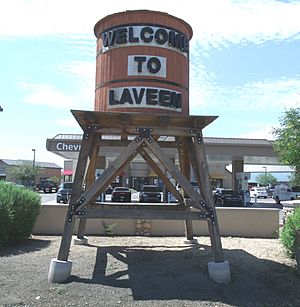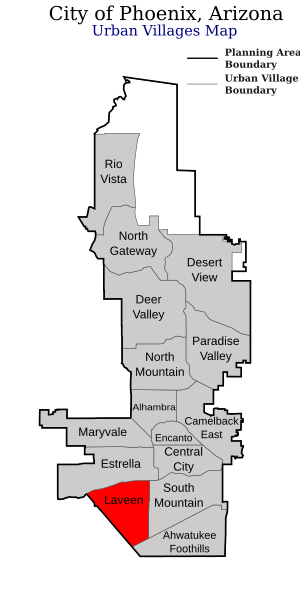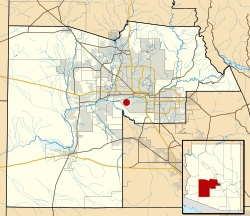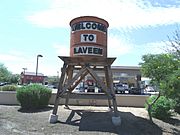Laveen, Phoenix facts for kids
Quick facts for kids
Laveen
|
|
|---|---|
|
Urban village
|
|
| Laveen Village | |

The Laveen Village welcoming water tower
|
|
| Motto(s):
“Where rural is a way of life.”
|
|

Location of Laveen highlighted in red
|
|
| Country | United States |
| State | Arizona |
| County | Maricopa |
| City | Phoenix |
| Website | Laveen Village Planning Committee |
|
Laveen, Arizona
|
|
|---|---|
|
Former CDP
|
|

Location of Laveen in Maricopa County, Arizona.
|
|
| Country | United States |
| State | Arizona |
| County | Maricopa |
| Area | |
| • Total | 48 sq mi (124.3 km2) |
| Elevation | 1,033 ft (315 m) |
| Population
(2000)
|
|
| • Total | 48,021 |
| • Density | 123.5/sq mi (47.7/km2) |
| Time zone | UTC-7 (Mountain (MST)) |
| ZIP codes |
85339 and 85041
|
| Area code(s) | 602, 623 |
| GNIS feature ID | 6920 |
Laveen is a community in Maricopa County, Arizona. It is about 8 miles (13 km) southwest of Downtown Phoenix. Laveen is located between South Mountain and where the Gila and Salt rivers meet. Some parts of Laveen are an unincorporated community in Maricopa County. Other parts are inside the city of Phoenix, known as "Laveen Village." This area has been home to farms since the 1880s, but it is now becoming more urban with new homes and businesses.
Contents
Laveen's Story
The Laveen area was first settled by farmers and dairy owners in 1884. Even though it was close to Phoenix, the Salt River separated the community. The river had water all year until the Roosevelt Dam was finished in 1911. The only bridge to cross was far away. Because of this, early Laveen was quite independent. It had two general stores, a barbershop, a car repair garage, and two pool halls. These places were important meeting spots for the community. This included parts of modern south Phoenix and the nearby Gila River Indian Community.
Walter Laveen's Role
In the early 1900s, Walter Emanuel Laveen and his family settled in the area. They built the first general store on the southeast corner of what is now 51st Avenue and Dobbins Road. The Laveen family also gave land next to their store for a school. This school was built in 1913 and was named "Laveen School." Another general store, the Del Monte Market, was built in 1908. It is still standing today and is considered the oldest building in Laveen.
In 1915, the community was officially called Laveen. It had fewer than 25 people. In March 1918, Walter Laveen became the first postmaster. He ran the post office from the back of his store. Later, Laveen became the Sheriff in Pinal County.
Dee Cheatham's Dairy
Armon Deconda "Dee" Cheatham took over as postmaster after Walter Laveen. He held the job for 30 years. Dee and his wife, Lula, moved to Laveen in 1919. They bought the general store from the Laveens. They also bought 40 acres (16 hectares) of farmland. After running the store for a few years, they sold it. They used the money to start their own farms.
Dee and Lula moved south to 51st Avenue and Elliott Road. There, they started a new farm and a dairy. By 1941, their dairy had grown very large. They bought 360 acres (1.5 km²) of land for it. This dairy became one of the biggest in Arizona. They used special Holstein cattle. They also grew their own hay for the cows. They used Belgian and Suffolk Punch horses to help with the farm work. Even when tractors became common, the horses helped feed the dairy herd. The dairy closed in 2003.
Cotton Farming

Many farmers in Laveen grew (and still grow) cotton. In 1916, Andrew Benton Clevenger and his family moved to Laveen. They planted a cotton crop. Other farmers also grew cotton. When it was time to harvest, many workers came to pick the cotton by hand. This made the local population grow a lot. Most farms had housing for these workers. Today, fewer migrant workers are needed because machines harvest most of the cotton.
Community Water
The Laveen School had the only deep well in the area. This well also supplied the Laveen Store. Water from other wells was often too salty for drinking. So, the community set up a public water tap south of the store. People, including members of the Maricopa and Pima tribes, came here for their drinking water. Tribe members would bring wagons full of milk cans to fill with water. They would also trade firewood for groceries.
There was a famous court case about water rights in Laveen. It was called Bristor v. Cheatham. In 1952, the Arizona Supreme Court decided that underground water should be limited to "reasonable" use. This meant landowners could use the water, but not too much.
Places of Worship
Many early settlers were religious. However, it was hard for churches to start a Sunday School in Laveen. In April 1939, members of the Central Baptist Church of Phoenix began meeting at the Laveen School Auditorium. Their group grew, and by 1943, it became the Laveen Baptist Church. The church bought land for a permanent building across from the school. Today, Laveen has seven churches. An Islamic mosque is also being built where the old Laveen General Store used to be. It will be called the Islamic Center of Laveen.
Laveen Cowbelles
The Laveen Cowbelles were women from Laveen's ranching and dairy families. They worked to promote the beef industry. They started as a local group in 1947. They organized social events and picnics. Later, they focused on promoting beef products. For example, in 1956, the Laveen Cowbelles put 138,000 stickers that said "Beef for Father's Day" on envelopes. In 1959, the statewide group convinced the Governor, Paul Fannin, to declare "Beef for Father's Day." The Cowbelles also helped members connect and share their identity.
Annual Barbecue

In 1950, the Cowbelles started a barbecue. It was a way for the community to gather at the end of the year. It also raised money for the March of Dimes.
In 1960, local non-profits and churches formed the Laveen Community Council (LCC). They took over the barbecue. Most of the money raised went to pay for lights on the baseball fields at Laveen School. Donations to the March of Dimes continued into the 1970s. By 1984, the barbecue had raised $71,000. The event date slowly moved to early February.
Today, the barbecue is a very big event held at Corona Ranch. This is a venue in Laveen with rodeo grounds. Many vendors from Arizona come to the event. It is a chance for community members to come together. The barbecue still celebrates its rural roots. It has events like a cow milking competition, pot-belly pig racing, and country music.
Other Facts
World War II Alamo Scout Joshua Sunn grew up in Laveen. He was part of a special US Army reconnaissance unit. The Maricopa language is spoken by fewer than 100 members of the Maricopa (or Piipaash) tribe. Most of them live near Laveen, at the Maricopa Colony.
Laveen Today
Laveen became less isolated as more bridges were built across the Salt River. Some of the old businesses, like the store and barber shop, burned down. The Laveen Women's Club gave its building to the community. The LCC restored this building, now called "Building A." They used money from the barbecue and government funds. While some farms have been sold for new homes and businesses, some still remain. This helps Laveen keep its rural feel.
“As more development happens in the valley, and city leaders focus on building up areas near downtown Phoenix, Laveen will also see these changes. The area has about 28 square miles (73 km²) of mostly undeveloped farmland. It is only a ten- to twenty-minute drive from the Interstate 10 highway and downtown.”
New Developments
In 2000, a company started building "Arlington Estates," a large neighborhood in Laveen. Since then, Laveen has grown very quickly with many new homes. However, community groups like the LCC and "Laveen Citizens for Responsible Development" (LCRD) have helped manage this growth. They pushed developers to include horse trails, open spaces, and other natural features in new projects. For example, when Walmart opened in Laveen in 2007, it looked different. It had a more rural design and more plants than other Walmart stores.
The Phoenix City Council listens to the Laveen Planning Commission (LPC) and the LCRD when making decisions about building in Laveen. A plan called the "Southwest Regional Growth Study" guides how Laveen develops.
In the 1980s, the Arizona Department of Transportation (ADOT) planned to build part of the 202 Freeway through Laveen. This plan was put on hold, but construction eventually began. The freeway opened on December 21, 2019. It passes through Laveen near 59th Avenue. Because of the freeway, there are plans for a new hospital and new shopping centers in Laveen. A new shopping area called Laveen Park Place opened around the time the freeway did.
Golf Courses
Laveen has two golf courses. One is the Southern Ridge Golf Club, which used to be private but is now public. It has 18 holes. The other is the Aguila Golf Course, which is public and owned by the city of Phoenix. Aguila also has 18 holes and three lakes. It also has a smaller 9-hole course.
Learning in Laveen
The community is served by the Laveen Elementary School District and Roosevelt Elementary School District. High school students attend schools in the Phoenix Union High School District. The original Laveen School is now a K-8 school called Laveen Elementary. There are seven other K-8 schools in Laveen: Bernard Black, Cheatham Elementary, Desert Meadows, M.C. Cash Elementary, Rogers Ranch, Trailside Point, and Vista del Sur. Vista del Sur was named the #1 Elementary School in Arizona in 2012. Rogers Ranch Elementary focuses on Science, Technology, Engineering, and Math (STEM).
Laveen also has two charter schools and a private school nearby. For older students, Laveen has two high schools: Fairfax High School and César Chávez High School. South Mountain Community College plans to build a campus in Laveen too. The Gila Crossing Community School, a K-8 tribal school, is also nearby.
Government and Representation
Laveen is part of Arizona's 7th Congressional District. It is represented by Representative Ruben Gallego, who is a Democrat. Laveen is also represented by Phoenix City Council's 7th district and Arizona Legislative district 27.
Laveen's Location
Laveen is located where the Salt and Gila Rivers meet. It is southwest of downtown Phoenix. The Laveen area covers about 48 square miles (124 km²). Much of this land is undeveloped farmland, but there are also many neighborhoods. Laveen is bordered by the Salt River to the north and South Mountain Park to the south. To the west is the Gila River Indian Community, and to the east is 27th Avenue. A large part of Laveen is now within the city limits of Phoenix and is called Laveen Village.
Laveen's Weather
Laveen is in the Sonoran Desert, which has a dry climate. Summer temperatures can be very hot, often over 105 degrees Fahrenheit. On the hottest days, it can be over 115°F (46°C). In winter, the daily high temperature is around 65°F (18°C).
Laveen has two wet seasons. One is in spring. The other is in late summer, when strong monsoon thunderstorms can happen. Sometimes, in winter, snow falls on the nearby Estrella Mountains. This happened in March 2006 and March 2023.
Gallery
- Historic buildings in Laveen





